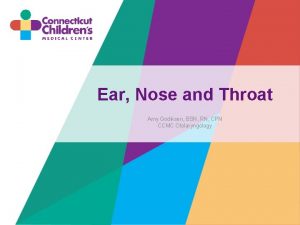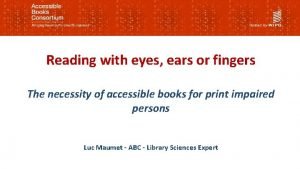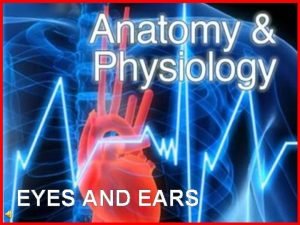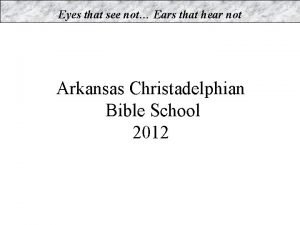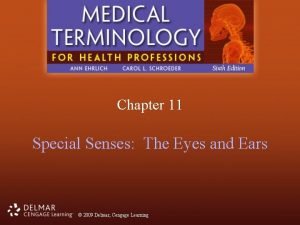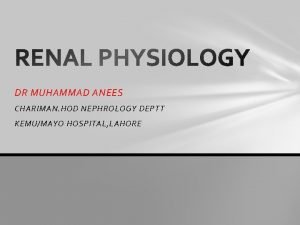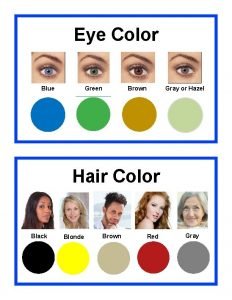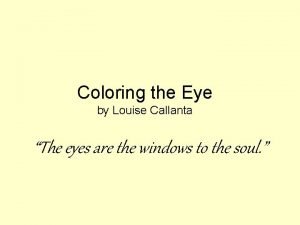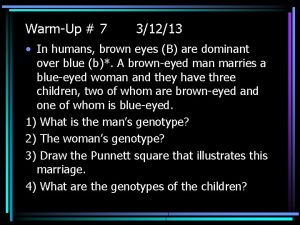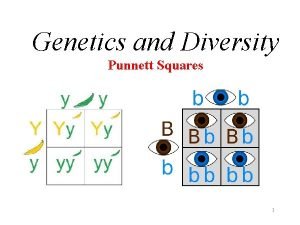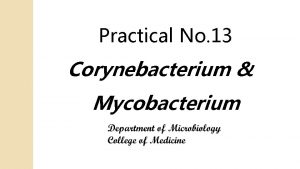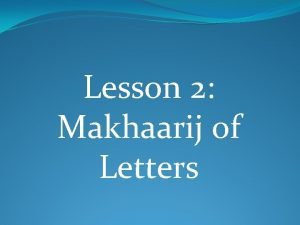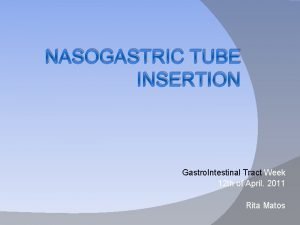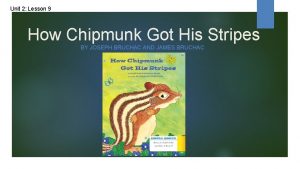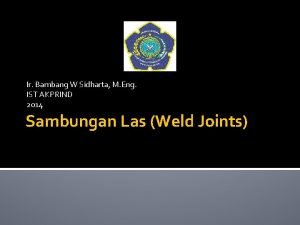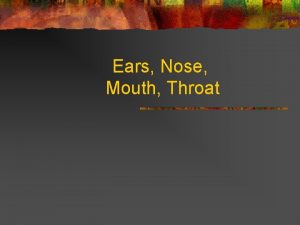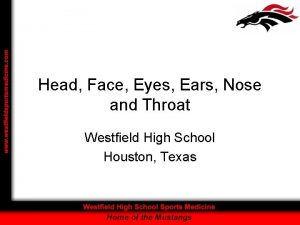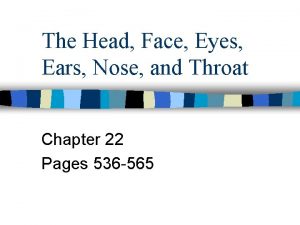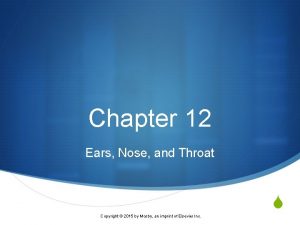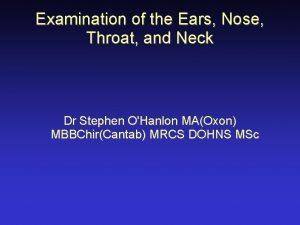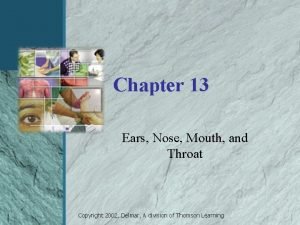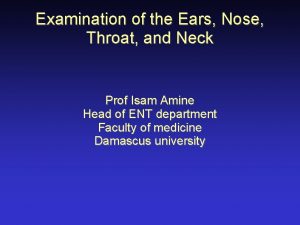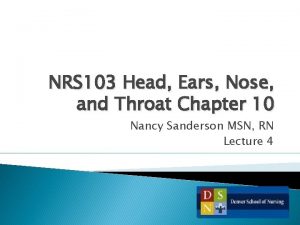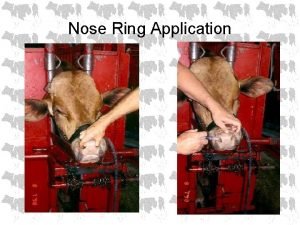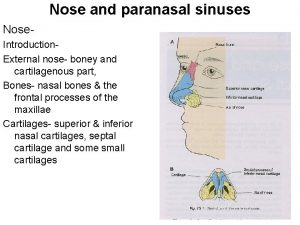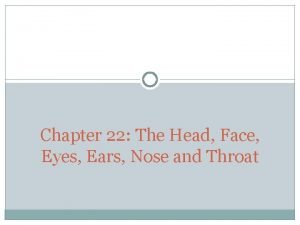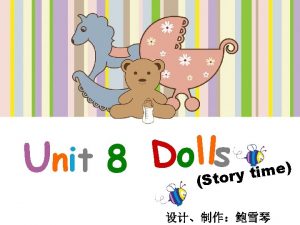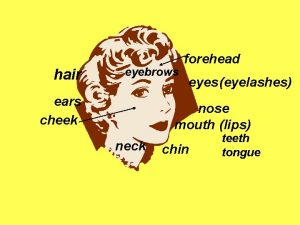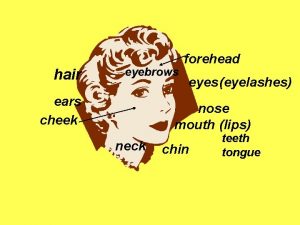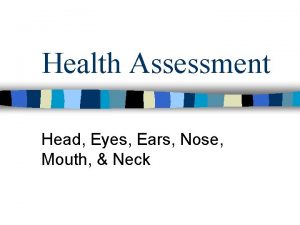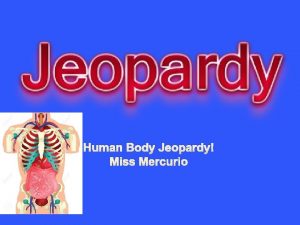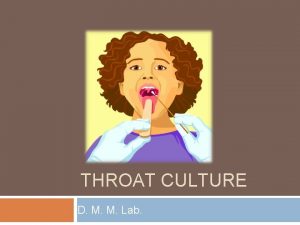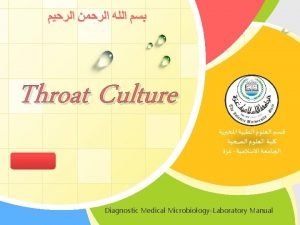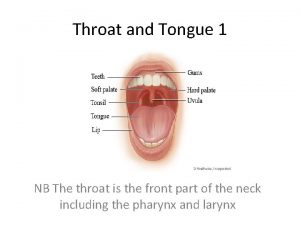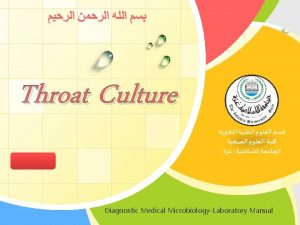Eyes Ears Nose Throat PN 2 Summer Semester





















- Slides: 21

Eyes, Ears, Nose & Throat PN 2 Summer Semester

Eyes Infants and Children: • At birth eyes symmetrical; pupils equal and respond to light • Iris is brown or slate gray-blue • By 3 months colour changes • Eyelids edematous; little or no tears which begin a 4 weeks • Vision in both eyes begin at 6 weeks • Eyes fully grown at age 8 • Red reflex at birth

Eyes Pregnant Female: • May c/o dry eyes (contact lenses) • Visual changes d/t shifting fluid in cornea • Blurriness or distortion of vision can occur because of temporary changes in shape of eye in last trimester and first 6 weeks post partum.

Eyes Older Adults: • Age 45 lens looses elasticity; ciliary muscle becomes weaker = near vision become a problem (presbyopia) • Droopy eye lids d/t decrease fat • Decrease tear formation • Cornea cloudy • Light reflex slower • Cateracts; macular degeneration • Narrow blood vessels

Considerations Cultural and environmental: • Blindness in poorer countries • Excessive sun exposure • Vitamin A deficiency • Discard makeup after 3 mos • Trauma in the workplace • Excessive sun may lead to cataracts

Doing the Eye Assessment • • • General questions Questions r/t illness or infection Questions r/t symptoms or behaviours Questions r/t to pain Questions r/t to age Questions r/t occupations/environment

Physical Assessment • Provide specific clear instructions • If you ask someone to read something…make sure they can read. • Place card over “closed” eye; do not actually close or apply pressure • Lighting in room should be adjustable • Need at least 20 feet of space • Use standard precautions

Snellen Eye Chart • Results recorded as fractions • Numerator=distance from chart • Denominator=distance where ct with normal vision can read line • Normal 20/20 • 20/30 = at 20 ft ct can read what normal person reads at 30 ft. • If ct is unable to read ½ of line, record the number of line above • Smaller the fraction=worse vision • 20/200 is legal blindness

Visual tests • We will do these when we do cranial nerve assessment • Visual fields • 6 cardinal fields of gaze • Corneal light reflex • Cover test • Pupillary response

Eye lids • • Conjunctiva Sclera Skin cancer Eye lid inflammation Cataract Conjunctiva Ectropian/entropion Trauma

Ears, Nose and Throat Infants and Children: • Auditory canal is short with upward curve • Children (age 3) have horizontal tube • Nose of child is too small to really examine • Salivation begins at 3 months • Drooling occurs until baby learns to swallow

ENT Pregnant Female: • Estrogen levels cause increase vascularity • Vessels change in middle ear • Increase blood flow in sinuses • Sense of smell increases • Edema of vocal cords • Sometimes over growth of gums

ENT Older Adult • Hair in ears • Ears become more prominent • Tympanic membrane paler and thicker • Lips and buccal mucosa become thinner and less vascular • More fissures on tongue; decreased taste, saliva • Gums recede and tooth decay

Psychosocial Considerations • Stress = mouth ulcers and lip biting • Clenching or grinding of teeth Cultural and Environmental Considerations • Teeth size and decay • Occupation and hearing • Finances/health care insurance

Interview General questions Questions r/t illness and infection Questions r/t to symptoms and behaviour Questions r/t pain Questions r/t environment Questions r/t age Questions r/t nose and sinus; mouth and throat

Physical Assessment • Inspection; palpation; percussion; trans illumination of sinuses • Tuning fork, otoscope and nasal speculum

Ear/hearing • Binaural hearing • Ears symmetrical in size, shape, colour and configuration • External auditory canal is patent and free of drainage • External ear and mastoid process are free of lesions and tragus is movable • When viewing through otoscope the external ear is open, non tender, free of lesions, inflammation and F/O’s • Cerumen is soft and small amt.

Ear/hearing • Tympanic membrane is flat, gray and translucent • Malleolar process and reflected light are visible on tympanic membrane • TM flutters with Valsalva • During hearing test, air conduction is longer than bone conduction • Adults are able to maintain balance

Hearing loss • Noise induced hearing loss from exposure to loud music or machinery common cause of hearing loss in adult aged 20 to 40 • Hearing loss in older adults common and is either senorineural or conductive loss • Presbycosis: occurs around age 50 and gets worse

Nose/Sinuses • Infants: obligatory nose breathers • Nose is only external organ of the resp track • Nasal mucosa is rich in blood supply and filters inspired air. • Olfactory cells are in roof of nose • Sinuses are mucous lined, air-filled cavities that warm, filter and moisten air

Mouth and Throat • Teeth, lips, gums (buccal mucosa), cheeks, tongue, hard and soft palate, uvula, manibular arch and maxillary arch • Tongue: check for adhesions; taste • Palate: check for cleft • Throat: tonsils
 Ccmc ear nose and throat
Ccmc ear nose and throat Low-set ears vs normal
Low-set ears vs normal Nose
Nose Convex nasal ridge
Convex nasal ridge Impaired eyes and ears
Impaired eyes and ears Hear us from heaven jared anderson
Hear us from heaven jared anderson Special senses the eyes and ears
Special senses the eyes and ears Eyes that see not ears that hear not
Eyes that see not ears that hear not Eyes are to spectacles as ears are to
Eyes are to spectacles as ears are to Let him who has ears to hear
Let him who has ears to hear Chapter 11 learning exercises medical terminology
Chapter 11 learning exercises medical terminology Pf
Pf Hazel vs green eye color
Hazel vs green eye color Eyes punnett square
Eyes punnett square Brown eyes are dominant to blue eyes
Brown eyes are dominant to blue eyes Punnett square example
Punnett square example Corynebacterium diphtheriae
Corynebacterium diphtheriae February 3 saint
February 3 saint Arabic alphabet makhraj
Arabic alphabet makhraj How to measure ng tube insertion
How to measure ng tube insertion How the whale got his throat comprehension questions
How the whale got his throat comprehension questions Ukuran leher las (throat) pada sambungan sudut (t) adalah
Ukuran leher las (throat) pada sambungan sudut (t) adalah
